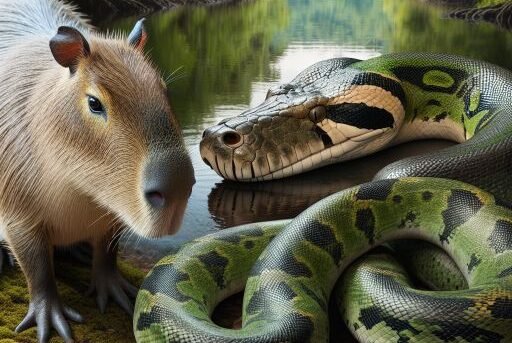Location and Habitat
The capybara, the world’s largest rodent, thrives in the water-rich regions of South America. These semi-aquatic mammals are commonly found in swamps, marshes, and rivers, where they can easily access their preferred diet of water plants and grasses. Capybaras are highly social creatures, often seen in groups, which helps them protect against predators.
On the other hand, the anaconda, one of the largest and most powerful snakes in the world, is also native to South America. These formidable reptiles predominantly inhabit slow-moving rivers, swamps, and marshes of the Amazon and Orinoco basins. Anacondas are excellent swimmers and often submerge themselves in water, lying in wait for prey, which includes a wide range of animals, even occasionally crossing paths with the capybara.
Capybara vs. Anaconda Comparison
| Animal | Size and Weight | Ability to Finish Opponent | Weaponry |
|---|---|---|---|
| Capybara | 106 to 174 cm in length; 35 to 66 kg in weight | Low (primarily a peaceful, social animal) | Teeth for grazing, not effective in combat |
| Anaconda | Up to 9 m in length; can weigh over 227 kg | High (excellent swimmer, constrictor, capable of overpowering large prey) | Powerful muscular body, constricting ability, sharp teeth |
“`
Hunting and Skills
Capybaras are large rodents native to South America, primarily feeding on grasses, aquatic plants, fruits, and tree bark. They are social animals, living in groups which helps in protection against predators. Their main defense mechanisms include excellent swimming abilities to escape threats and using their sharp senses to detect predators. Anacondas, on the other hand, are one of the largest and most powerful snakes in the world, residing in the same regions as capybaras. They are non-venomous constrictors, preying on a variety of animals including fish, birds, caimans, and occasionally capybaras. Anacondas utilize their camouflaged skin to ambush prey, coiling around it and suffocating it before consumption. They are adept swimmers, which makes them formidable hunters in aquatic and semi-aquatic habitats.
Capybara vs. Anaconda Who Would Win?
The anaconda attacks first, attempting to coil around the capybara. The capybara struggles, trying to escape the anaconda’s grip. The anaconda’s strength and size give it an advantage in subduing the capybara. Despite the capybara’s efforts to bite and free itself, the anaconda eventually overpowers it. The anaconda constricts the capybara until it succumbs.
Winner: Anaconda with 80% chance of winning.




